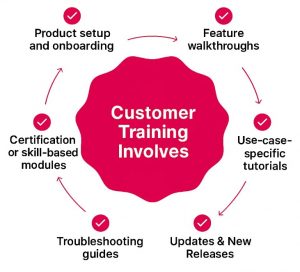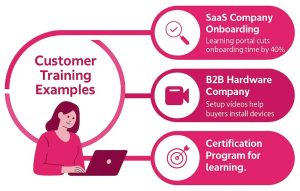You have built a solid product. Now what?
If your customers aren’t equipped to get the most out of it, you’re leaving value on the table. That’s where customer training makes all the difference.
Customer training is no longer just a “nice-to-have” — it’s a strategic investment that boosts product adoption, reduces churn, and builds long-lasting relationships. And, when delivered effectively using a modern Learning Management System (LMS), it can scale with your business and evolve with your customers’ needs.
Whether you’re a SaaS startup onboarding new users, an enterprise offering technical solutions, or a manufacturing company with complex products — customer training empowers your users to realize value faster and with greater confidence.
This guide explores the meaning of customer training, its business impact, and how to launch an effective LMS-driven program.
Want more loyal, confident users and fewer support tickets? Read on.
What is Customer Training?
Customer training refers to the process of educating your customers on how to use your product or service effectively. It includes everything from onboarding tutorials and help center articles to full-scale training academies and certifications. The goal is to help customers become self-sufficient, informed, and empowered users.

Unlike internal training, which focuses on employees, customer training is external-facing. It ensures your customers understand key features, workflows, and best practices that align with their goals. This is especially vital for companies offering complex, technical, or software-based solutions.
Customer training often covers:
- Product setup and onboarding
- Feature walkthroughs
- Use-case-specific tutorials
- Troubleshooting guides
- Certification or skill-based modules
Benefits of Customer Training
Customer training offers numerous strategic advantages that directly impact your business growth. When delivered effectively — especially through a powerful LMS — the benefits extend far beyond just product knowledge.
Let’s explore the five key benefits in detail.
1. Increases Product Adoption
Many users only tap into a small portion of available features—not because they’re not useful, but because they don’t know how to use them effectively. Structured training closes this gap by guiding customers through the capabilities that matter most.
With targeted onboarding and feature-specific tutorials, users gain the confidence to explore your product more fully and integrate it into their daily workflows. The result? Deeper engagement, stronger product adoption, and long-term retention.
A Learning Management System (LMS) makes this training scalable and consistent. By assigning role-based learning paths or tailoring content to specific use cases, companies can drive adoption across a broad customer base—without overwhelming internal teams.
2. Reduces Churn
Customer churn often stems from a lack of understanding—not dissatisfaction.
When users don’t know how to extract value from your product, frustration builds. Training changes that by guiding them through key workflows, addressing pain points early, and helping them succeed faster.
When customers feel empowered and supported, their overall satisfaction increases. They’re less likely to seek alternatives or churn due to avoidable confusion or lack of support.
A well-designed LMS helps automate these retention efforts by providing timely, proactive training based on usage patterns. This keeps customers engaged and loyal for the long term.
3. Lowers Support Costs
Customer training reduces the need for reactive customer support. When users know how to complete tasks, troubleshoot issues, or explore new features on their own, they’re less likely to reach out for help.
This lightens the load on your customer success and technical support teams, allowing them to focus on more complex, high-priority requests. It also improves resolution times and reduces overhead costs.
With an LMS, you can offer self-paced training, searchable resources, and on-demand help — ensuring customers can find answers quickly without relying on your support staff.
4. Improves Customer Loyalty
A customer educated on your product and services is more likely to become a loyal customer. Training shows your brand’s commitment to their success, building trust and long-term goodwill. It helps customers view your business as a partner rather than just a vendor.
Loyal customers stay longer, expand their usage, and become champions for your product. By boosting their confidence, efficiency, and satisfaction, training plays a direct role in deepening that loyalty.
With an LMS, you can deliver consistent, value-driven education across the entire customer journey—from onboarding and adoption to expansion and renewal—reinforcing your brand’s value at every touchpoint.
5. Unlocks Upselling & Expansion Opportunities
Customer training opens doors to organic upsell and cross-sell opportunities. When users are confident in using your core product, they’re more receptive to advanced features, add-ons, or higher-tier plans.
Education creates a natural pathway for customers to grow with your product. Through in-depth tutorials or feature-focused courses, you can introduce premium functionalities in a value-driven context.
With an LMS, this education can be delivered strategically—based on usage data or where the customer is in their journey—transforming training into a revenue-generating channel and increasing customer lifetime value.
Examples of Customer Training in Action

SaaS Company Onboarding
A project management software provider creates a learning portal with onboarding tutorials, live webinars, and feature deep-dives. New users complete the courses within the first week and reduce onboarding time by 40%.
B2B Hardware Company
A manufacturer of IoT devices offers step-by-step setup videos and troubleshooting guides through an LMS. This helps technical buyers install and maintain devices without field service calls.
Certification Program for Partners
A cybersecurity platform launches a customer academy with role-based learning paths. Customers complete training and receive certifications, which also act as a trust signal for end clients.
How to Build a Customer Training Program
Creating an effective customer training program isn’t about throwing together a few Help articles. It requires a thoughtful, strategic approach.
Step 1: Define Your Goals
Start with the “why.” Are you aiming to reduce churn? Decrease support tickets? Drive feature adoption? Your goals will shape your content and delivery strategy.
Step 2: Know Your Audience
Segment your customer base. First-time users have different needs than power users. Consider roles, industries, regions, and technical ability.
Step 3: Decide on Content Formats
Choose a mix of engaging content:
- Video walkthroughs
- Interactive modules
- Live or recorded webinars
- Downloadable PDFs or guides
- Knowledge base articles
- Quizzes or assessments
Step 4: Choose the Right Delivery Method
Choose the format that best fits your customers’ needs:
- Asynchronous: Self-paced learning through on-demand courses, videos, or tutorials
- Synchronous: Real-time sessions such as live webinars, virtual classes, or instructor-led training
- Blended: A combination of both—mixing the flexibility of self-paced learning with the engagement of live sessions
Step 5: Collect Feedback and Iterate
Use surveys, course ratings, and completion rates to optimize your content. Your customer training programs should evolve as your product and user needs change.
This is where an LMS becomes critical — more on that below.
The Role of LMS in Customer Training
A Learning Management System (LMS) is the backbone of a successful customer training strategy. It allows you to centralize, automate, and scale training content for different customer segments.
Here’s how it helps:
1. Centralised Content Delivery
An LMS provides a single platform where users can access training materials, regardless of their location or time zone.
2. Personalised Learning Paths
Many modern LMS platforms, like Beetsol LMS, offer AI-powered customization, guiding customers through learning journeys based on their role, product usage, or skill level.
3. Progress Tracking
You can track completion rates, quiz scores, time spent per course, and identify where users are dropping off — giving you clear data to improve content.
4. Certification & Motivation
Awarding digital certificates boosts user engagement and creates a sense of achievement. It’s particularly effective in technical or regulated industries.
5. Scalable Training
As your customer base grows, so do your training programs. A cloud-based LMS ensures you can deliver consistent training to thousands of users with minimal overhead.
What to Look for in a Customer Training LMS
Not all LMS platforms are designed with external users in mind. When choosing one for customer training, prioritize these features:
- Ease of use: Clean interface for non-technical users
- Mobile accessibility: Training on-the-go
- AI-driven personalization: Suggests content based on roles and product interests
- CRM integration: Sync with HubSpot, Salesforce, etc.
- Multi-language support: For global training
- Analytics and reporting: Real-time performance metrics
And most importantly
- One with a truly embedded experience with white-labeling: So your customer portal matches your brand
Case Study: Using Beetsol LMS for Customer Education
A mid-sized SaaS company switched to Beetsol LMS to improve its customer onboarding program. Through personalized learning paths, progress tracking, and integrated webinars, they saw a:
- 35% drop in support queries in the first 90 days
- 12% higher customer retention rate over 6 months
- 20% increase in upsell conversions after certification
This shows how the right LMS not only educates customers but directly impacts business growth. For more information, check our FAQ’s.
Choose the Right LMS for Customer Training
Customer training is more than education—it’s the key to empowering your users to succeed.
With the right LMS, you deliver engaging, scalable training that fuels product adoption, builds loyalty, and accelerates revenue growth.
As customer expectations soar, the companies that invest in truly enabling their users will rise above the competition. Whether launching your first program or scaling an existing one, investing in customer education through an LMS is one of the smartest—and most strategic—moves your business can make.
